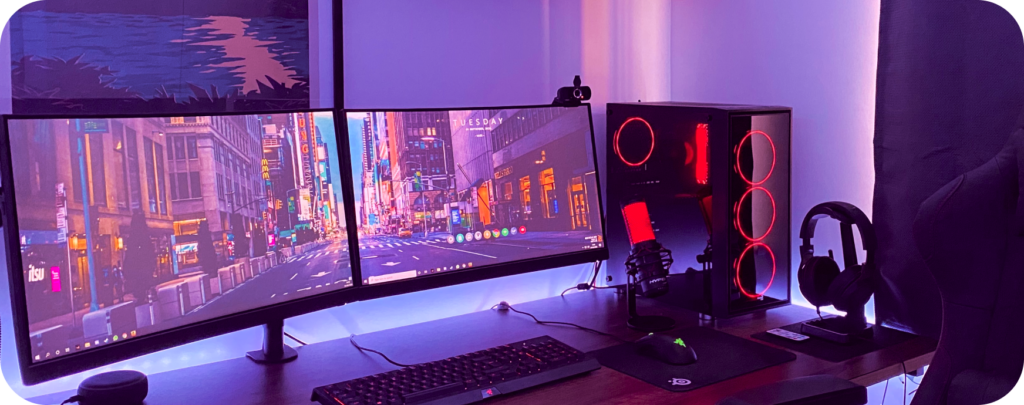If you or someone in your family plays video games, you’ve probably heard of the term “ping,” but you may not understand what it means. It plays a critical role in how a user experiences a game. Ping refers to the time between a player’s input and the server’s response to that input. The input pings the server with a command, and the server pings back with a response that translates into the game. Read on to learn more about what makes a good ping, how to test it and how to improve it for a better gaming experience.
Is a High or Low Ping Good for Gaming?
Ping is measured in milliseconds (ms) and counts the delay between when you press a button and when an action occurs in a game. If you’re playing a multiplayer first-person shooter game like Call of Duty or Fortnite, look for a number at the top of your screen. This is the ping letting you know how fast, stable and accurate your connection to the game’s server is.
If your ping is high, each action will be delayed. For example, if you fire a shot at your opponent, they may be in a completely different location by the time the action registers. Alternatively, an opposing player could come around a corner and shoot at you before you can see them do it. In gaming situations where every millisecond counts, high ping is detrimental to your gaming experience.
What is a Good Ping?
A good ping for gaming is anything under 20ms, but ideally, you want your ping to be as low as possible. No internet connection can offer a 0ms ping, but 1ms is possible. That means it takes just one millisecond for your actions to reflect in-game.
Not sure if your ping is causing a disadvantage? Here is a breakdown of ping speeds and their impact on your experience:
- Under 20ms: This is an excellent ping, especially for competitive, fast-paced games where every millisecond counts.
- 20-50ms: At this ping, you should experience minimal lag for most online activities, like gaming, video calls and streaming.
- 50-100ms: This is the average ping for internet connections. It’s typically fine for casual gaming, but you may notice some delay in competitive gaming.
- 100-150ms: At this level, you may notice lag in games requiring quick response times, but video calls and streaming should be relatively smooth.
- Over 150ms: No matter your online activity, pings above this level will lead to lag.
How to Test Ping
Most online games allow you to test ping in the game settings. Look for display performance or network settings for the most accurate measure for the specific game and server you are playing on. You can also use third-party ping testing sites, such as Ping Sweep or Pingdom.
What Causes a High Ping?
Since high ping is caused by delays between devices communicating with gaming servers, there may be multiple underlying causes. Here are some of the most common reasons why your ping is high:
- Router location: If you’re not in the same room as your router, the signal must pass through more obstacles (walls, ceilings, furniture and other devices) before reaching your computer or console.
- Slow connection: A slow internet connection means it takes a long time to send and receive data. However, a strong internet connection is not enough to eliminate high ping on its own. The game servers you’re connected to need to have a fast internet connection as well.
- Too many devices on the same network: Network speed and ping can be affected by the number of devices sharing the bandwidth of your home network.
- Server location: Connecting to game servers on the other side of the country or abroad can cause performance issues due to the physical distance between your device and the server.
- Concurrent apps: If your computer downloads and installs updates in the background, it may become overworked and slow you down.
How to Lower Ping
Optimizing your network and freeing up bandwidth can decrease latency. Here are some adjustments you can make that can contribute to a lower ping:
- Check your router: Move your router closer to your gaming equipment, check that it’s running the latest firmware and restart it to clear temporary files that could cause connectivity issues.
- Run an internet speed test: A basic speed test will show your current upload and download speeds, latency and server location, which can help you identify the cause of your high ping. If your speeds are slowing you down, consider upgrading your internet plan.
- Remove other devices on your network: If your ping is suddenly high, remove any devices that are downloading files, streaming content or performing other activities that require a lot of bandwidth.
- Close apps and pause updates: Running unnecessary programs in the background takes up more bandwidth than you think, so schedule updates when you’re not actively playing.

Level Up Your Game with Uninterrupted Fiber Speeds
After you’ve done everything you can to lower your ping, you still may notice lagging in your gameplay. The problem could be your internet connection. With 2 Gig and 5 Gig fiber internet plans from Lumos, you can experience smooth, continuous gameplay thanks to ultra-fast upload and download speeds and enough bandwidth for all your gaming systems. You’ll enjoy low ping for a responsive, lag-free experience with every button pressed, whether you play by controller or keyboard.
Check for Lumos Fiber near you and discover how fiber internet can be your competitive advantage.


